The Dawn of Human Culture
VerifiedAdded on 2022/09/18
|7
|1627
|21
AI Summary
Contribute Materials
Your contribution can guide someone’s learning journey. Share your
documents today.

(Surname) 1
Student Name
Professor’s Name
Course
Date
Essay 1: Describe and elaborate on the significant changes in the evolution of stone tool
technology from the oldest stone tool through the upper paleolithic.
A stone tool is an artifact that is either partially or entirely made from stone. Artifacts that
are made depending from various societies and cultures present today, however, majority of
stone tools are majorly linked to the prehistoric cultures that are today nonexistent. It is vital to
note that Stone tools among other pieces of art is essential in providing evidence of how the early
humans formed objects (Nowell, April & Davidson, 118). Additionally, the artifacts reveal how
these people lived, related with the environment and how they advanced over time. Research
states that over the past 2.6 million years, many excavation locations have been dug, researched
and dated. The sites mostly comprise of fragments and remains accrued from the use of stone
tools (Shea, 179). It is evident that stone objects are less vulnerable to ruin as compared to bones,
and therefore provide the best suggestion of where the early people lived and their geographical
habitat. Most archeologists categorize the various stone tools into industries that share unique
technical or morphological features (Nowell, April & Davidson, 139).
The earliest stone age tools were approximately found 2.6 million years ago in the life
span of the genus Homo. The tools made were the most basic tools and were referred to as the
Oldowan Industry named after the famous Olduvai Gorge in Tanzania (Shea, 181). The tools
were categorized by simple construction using cores such as river pebbles and rocks. This
Student Name
Professor’s Name
Course
Date
Essay 1: Describe and elaborate on the significant changes in the evolution of stone tool
technology from the oldest stone tool through the upper paleolithic.
A stone tool is an artifact that is either partially or entirely made from stone. Artifacts that
are made depending from various societies and cultures present today, however, majority of
stone tools are majorly linked to the prehistoric cultures that are today nonexistent. It is vital to
note that Stone tools among other pieces of art is essential in providing evidence of how the early
humans formed objects (Nowell, April & Davidson, 118). Additionally, the artifacts reveal how
these people lived, related with the environment and how they advanced over time. Research
states that over the past 2.6 million years, many excavation locations have been dug, researched
and dated. The sites mostly comprise of fragments and remains accrued from the use of stone
tools (Shea, 179). It is evident that stone objects are less vulnerable to ruin as compared to bones,
and therefore provide the best suggestion of where the early people lived and their geographical
habitat. Most archeologists categorize the various stone tools into industries that share unique
technical or morphological features (Nowell, April & Davidson, 139).
The earliest stone age tools were approximately found 2.6 million years ago in the life
span of the genus Homo. The tools made were the most basic tools and were referred to as the
Oldowan Industry named after the famous Olduvai Gorge in Tanzania (Shea, 181). The tools
were categorized by simple construction using cores such as river pebbles and rocks. This
Secure Best Marks with AI Grader
Need help grading? Try our AI Grader for instant feedback on your assignments.
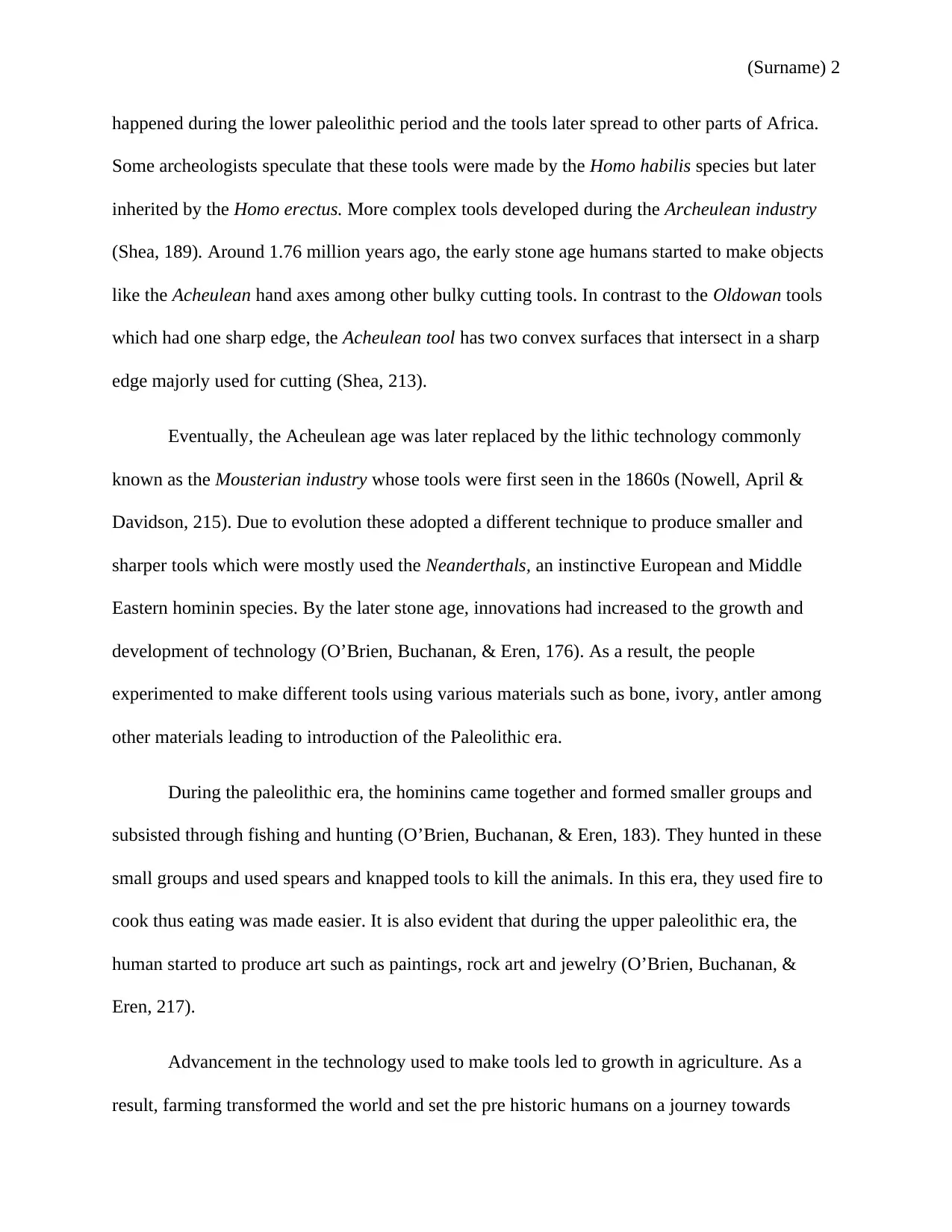
(Surname) 2
happened during the lower paleolithic period and the tools later spread to other parts of Africa.
Some archeologists speculate that these tools were made by the Homo habilis species but later
inherited by the Homo erectus. More complex tools developed during the Archeulean industry
(Shea, 189). Around 1.76 million years ago, the early stone age humans started to make objects
like the Acheulean hand axes among other bulky cutting tools. In contrast to the Oldowan tools
which had one sharp edge, the Acheulean tool has two convex surfaces that intersect in a sharp
edge majorly used for cutting (Shea, 213).
Eventually, the Acheulean age was later replaced by the lithic technology commonly
known as the Mousterian industry whose tools were first seen in the 1860s (Nowell, April &
Davidson, 215). Due to evolution these adopted a different technique to produce smaller and
sharper tools which were mostly used the Neanderthals, an instinctive European and Middle
Eastern hominin species. By the later stone age, innovations had increased to the growth and
development of technology (O’Brien, Buchanan, & Eren, 176). As a result, the people
experimented to make different tools using various materials such as bone, ivory, antler among
other materials leading to introduction of the Paleolithic era.
During the paleolithic era, the hominins came together and formed smaller groups and
subsisted through fishing and hunting (O’Brien, Buchanan, & Eren, 183). They hunted in these
small groups and used spears and knapped tools to kill the animals. In this era, they used fire to
cook thus eating was made easier. It is also evident that during the upper paleolithic era, the
human started to produce art such as paintings, rock art and jewelry (O’Brien, Buchanan, &
Eren, 217).
Advancement in the technology used to make tools led to growth in agriculture. As a
result, farming transformed the world and set the pre historic humans on a journey towards
happened during the lower paleolithic period and the tools later spread to other parts of Africa.
Some archeologists speculate that these tools were made by the Homo habilis species but later
inherited by the Homo erectus. More complex tools developed during the Archeulean industry
(Shea, 189). Around 1.76 million years ago, the early stone age humans started to make objects
like the Acheulean hand axes among other bulky cutting tools. In contrast to the Oldowan tools
which had one sharp edge, the Acheulean tool has two convex surfaces that intersect in a sharp
edge majorly used for cutting (Shea, 213).
Eventually, the Acheulean age was later replaced by the lithic technology commonly
known as the Mousterian industry whose tools were first seen in the 1860s (Nowell, April &
Davidson, 215). Due to evolution these adopted a different technique to produce smaller and
sharper tools which were mostly used the Neanderthals, an instinctive European and Middle
Eastern hominin species. By the later stone age, innovations had increased to the growth and
development of technology (O’Brien, Buchanan, & Eren, 176). As a result, the people
experimented to make different tools using various materials such as bone, ivory, antler among
other materials leading to introduction of the Paleolithic era.
During the paleolithic era, the hominins came together and formed smaller groups and
subsisted through fishing and hunting (O’Brien, Buchanan, & Eren, 183). They hunted in these
small groups and used spears and knapped tools to kill the animals. In this era, they used fire to
cook thus eating was made easier. It is also evident that during the upper paleolithic era, the
human started to produce art such as paintings, rock art and jewelry (O’Brien, Buchanan, &
Eren, 217).
Advancement in the technology used to make tools led to growth in agriculture. As a
result, farming transformed the world and set the pre historic humans on a journey towards

(Surname) 3
modernization (O’Brien, Buchanan, & Eren, 289). The technology helped in the invention of
plows that were used in farming. The Paleolithic people therefore learned to make other objects
that were needed for their survival. Therefore, weaving of baskets was vital technology in that
time.
modernization (O’Brien, Buchanan, & Eren, 289). The technology helped in the invention of
plows that were used in farming. The Paleolithic people therefore learned to make other objects
that were needed for their survival. Therefore, weaving of baskets was vital technology in that
time.
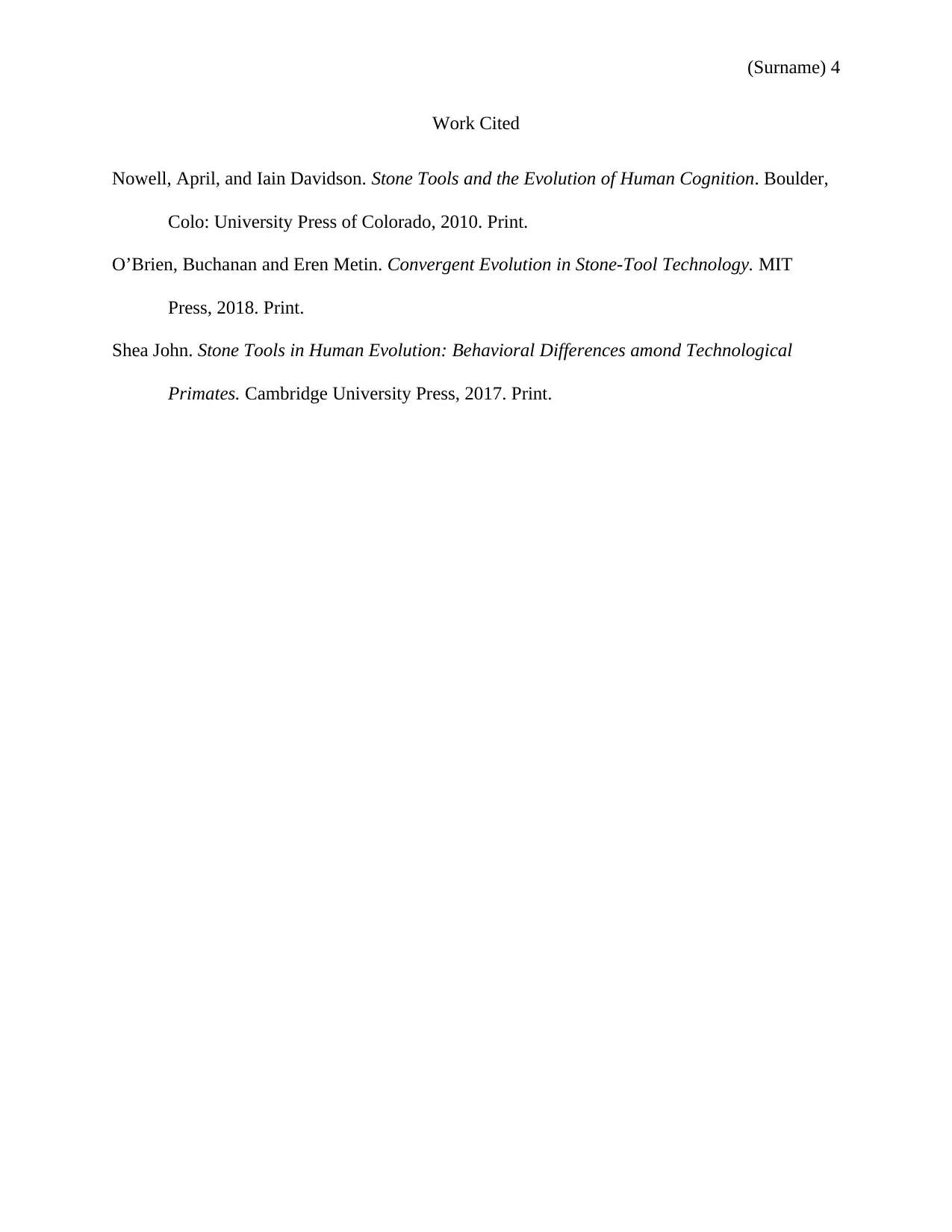
(Surname) 4
Work Cited
Nowell, April, and Iain Davidson. Stone Tools and the Evolution of Human Cognition. Boulder,
Colo: University Press of Colorado, 2010. Print.
O’Brien, Buchanan and Eren Metin. Convergent Evolution in Stone-Tool Technology. MIT
Press, 2018. Print.
Shea John. Stone Tools in Human Evolution: Behavioral Differences amond Technological
Primates. Cambridge University Press, 2017. Print.
Work Cited
Nowell, April, and Iain Davidson. Stone Tools and the Evolution of Human Cognition. Boulder,
Colo: University Press of Colorado, 2010. Print.
O’Brien, Buchanan and Eren Metin. Convergent Evolution in Stone-Tool Technology. MIT
Press, 2018. Print.
Shea John. Stone Tools in Human Evolution: Behavioral Differences amond Technological
Primates. Cambridge University Press, 2017. Print.
Secure Best Marks with AI Grader
Need help grading? Try our AI Grader for instant feedback on your assignments.
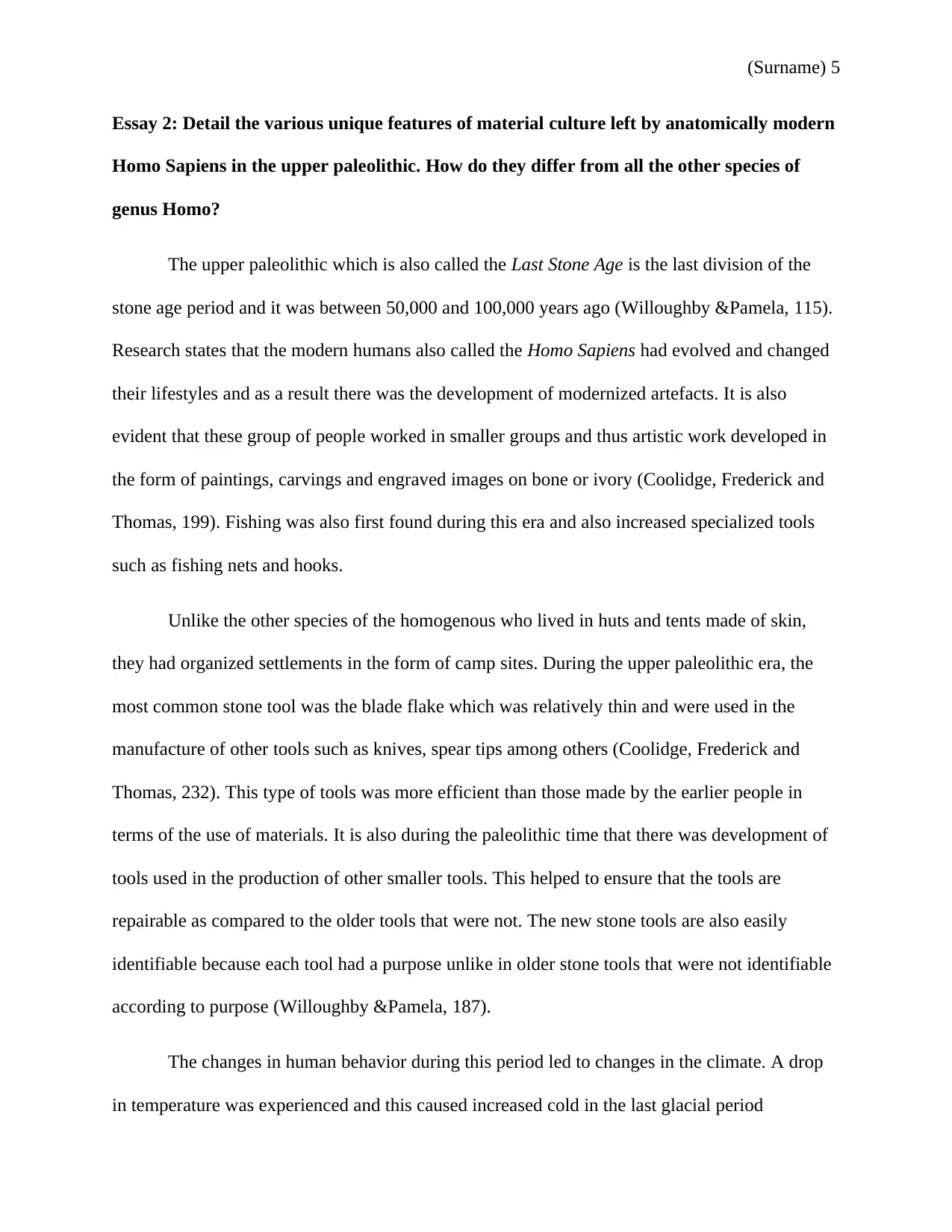
(Surname) 5
Essay 2: Detail the various unique features of material culture left by anatomically modern
Homo Sapiens in the upper paleolithic. How do they differ from all the other species of
genus Homo?
The upper paleolithic which is also called the Last Stone Age is the last division of the
stone age period and it was between 50,000 and 100,000 years ago (Willoughby &Pamela, 115).
Research states that the modern humans also called the Homo Sapiens had evolved and changed
their lifestyles and as a result there was the development of modernized artefacts. It is also
evident that these group of people worked in smaller groups and thus artistic work developed in
the form of paintings, carvings and engraved images on bone or ivory (Coolidge, Frederick and
Thomas, 199). Fishing was also first found during this era and also increased specialized tools
such as fishing nets and hooks.
Unlike the other species of the homogenous who lived in huts and tents made of skin,
they had organized settlements in the form of camp sites. During the upper paleolithic era, the
most common stone tool was the blade flake which was relatively thin and were used in the
manufacture of other tools such as knives, spear tips among others (Coolidge, Frederick and
Thomas, 232). This type of tools was more efficient than those made by the earlier people in
terms of the use of materials. It is also during the paleolithic time that there was development of
tools used in the production of other smaller tools. This helped to ensure that the tools are
repairable as compared to the older tools that were not. The new stone tools are also easily
identifiable because each tool had a purpose unlike in older stone tools that were not identifiable
according to purpose (Willoughby &Pamela, 187).
The changes in human behavior during this period led to changes in the climate. A drop
in temperature was experienced and this caused increased cold in the last glacial period
Essay 2: Detail the various unique features of material culture left by anatomically modern
Homo Sapiens in the upper paleolithic. How do they differ from all the other species of
genus Homo?
The upper paleolithic which is also called the Last Stone Age is the last division of the
stone age period and it was between 50,000 and 100,000 years ago (Willoughby &Pamela, 115).
Research states that the modern humans also called the Homo Sapiens had evolved and changed
their lifestyles and as a result there was the development of modernized artefacts. It is also
evident that these group of people worked in smaller groups and thus artistic work developed in
the form of paintings, carvings and engraved images on bone or ivory (Coolidge, Frederick and
Thomas, 199). Fishing was also first found during this era and also increased specialized tools
such as fishing nets and hooks.
Unlike the other species of the homogenous who lived in huts and tents made of skin,
they had organized settlements in the form of camp sites. During the upper paleolithic era, the
most common stone tool was the blade flake which was relatively thin and were used in the
manufacture of other tools such as knives, spear tips among others (Coolidge, Frederick and
Thomas, 232). This type of tools was more efficient than those made by the earlier people in
terms of the use of materials. It is also during the paleolithic time that there was development of
tools used in the production of other smaller tools. This helped to ensure that the tools are
repairable as compared to the older tools that were not. The new stone tools are also easily
identifiable because each tool had a purpose unlike in older stone tools that were not identifiable
according to purpose (Willoughby &Pamela, 187).
The changes in human behavior during this period led to changes in the climate. A drop
in temperature was experienced and this caused increased cold in the last glacial period
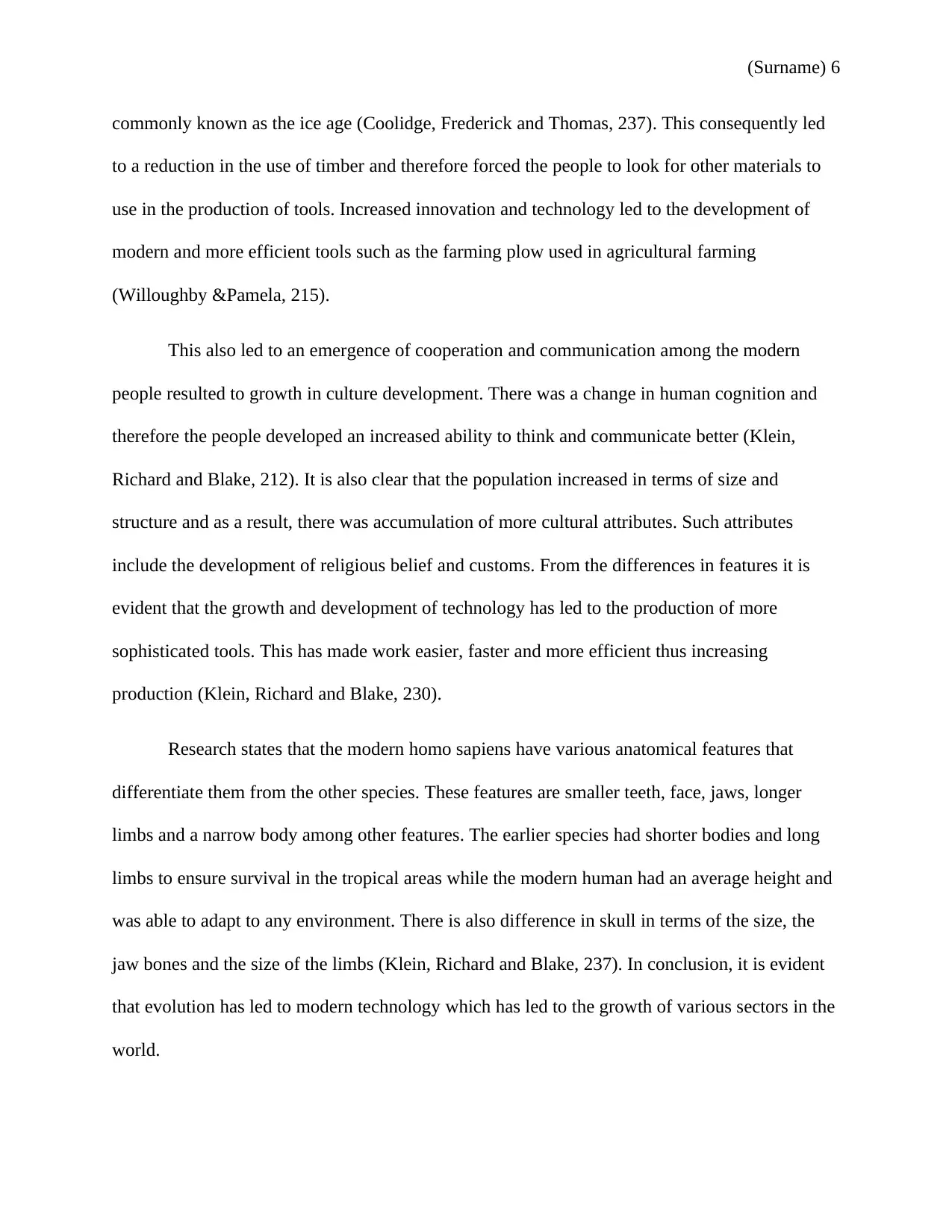
(Surname) 6
commonly known as the ice age (Coolidge, Frederick and Thomas, 237). This consequently led
to a reduction in the use of timber and therefore forced the people to look for other materials to
use in the production of tools. Increased innovation and technology led to the development of
modern and more efficient tools such as the farming plow used in agricultural farming
(Willoughby &Pamela, 215).
This also led to an emergence of cooperation and communication among the modern
people resulted to growth in culture development. There was a change in human cognition and
therefore the people developed an increased ability to think and communicate better (Klein,
Richard and Blake, 212). It is also clear that the population increased in terms of size and
structure and as a result, there was accumulation of more cultural attributes. Such attributes
include the development of religious belief and customs. From the differences in features it is
evident that the growth and development of technology has led to the production of more
sophisticated tools. This has made work easier, faster and more efficient thus increasing
production (Klein, Richard and Blake, 230).
Research states that the modern homo sapiens have various anatomical features that
differentiate them from the other species. These features are smaller teeth, face, jaws, longer
limbs and a narrow body among other features. The earlier species had shorter bodies and long
limbs to ensure survival in the tropical areas while the modern human had an average height and
was able to adapt to any environment. There is also difference in skull in terms of the size, the
jaw bones and the size of the limbs (Klein, Richard and Blake, 237). In conclusion, it is evident
that evolution has led to modern technology which has led to the growth of various sectors in the
world.
commonly known as the ice age (Coolidge, Frederick and Thomas, 237). This consequently led
to a reduction in the use of timber and therefore forced the people to look for other materials to
use in the production of tools. Increased innovation and technology led to the development of
modern and more efficient tools such as the farming plow used in agricultural farming
(Willoughby &Pamela, 215).
This also led to an emergence of cooperation and communication among the modern
people resulted to growth in culture development. There was a change in human cognition and
therefore the people developed an increased ability to think and communicate better (Klein,
Richard and Blake, 212). It is also clear that the population increased in terms of size and
structure and as a result, there was accumulation of more cultural attributes. Such attributes
include the development of religious belief and customs. From the differences in features it is
evident that the growth and development of technology has led to the production of more
sophisticated tools. This has made work easier, faster and more efficient thus increasing
production (Klein, Richard and Blake, 230).
Research states that the modern homo sapiens have various anatomical features that
differentiate them from the other species. These features are smaller teeth, face, jaws, longer
limbs and a narrow body among other features. The earlier species had shorter bodies and long
limbs to ensure survival in the tropical areas while the modern human had an average height and
was able to adapt to any environment. There is also difference in skull in terms of the size, the
jaw bones and the size of the limbs (Klein, Richard and Blake, 237). In conclusion, it is evident
that evolution has led to modern technology which has led to the growth of various sectors in the
world.
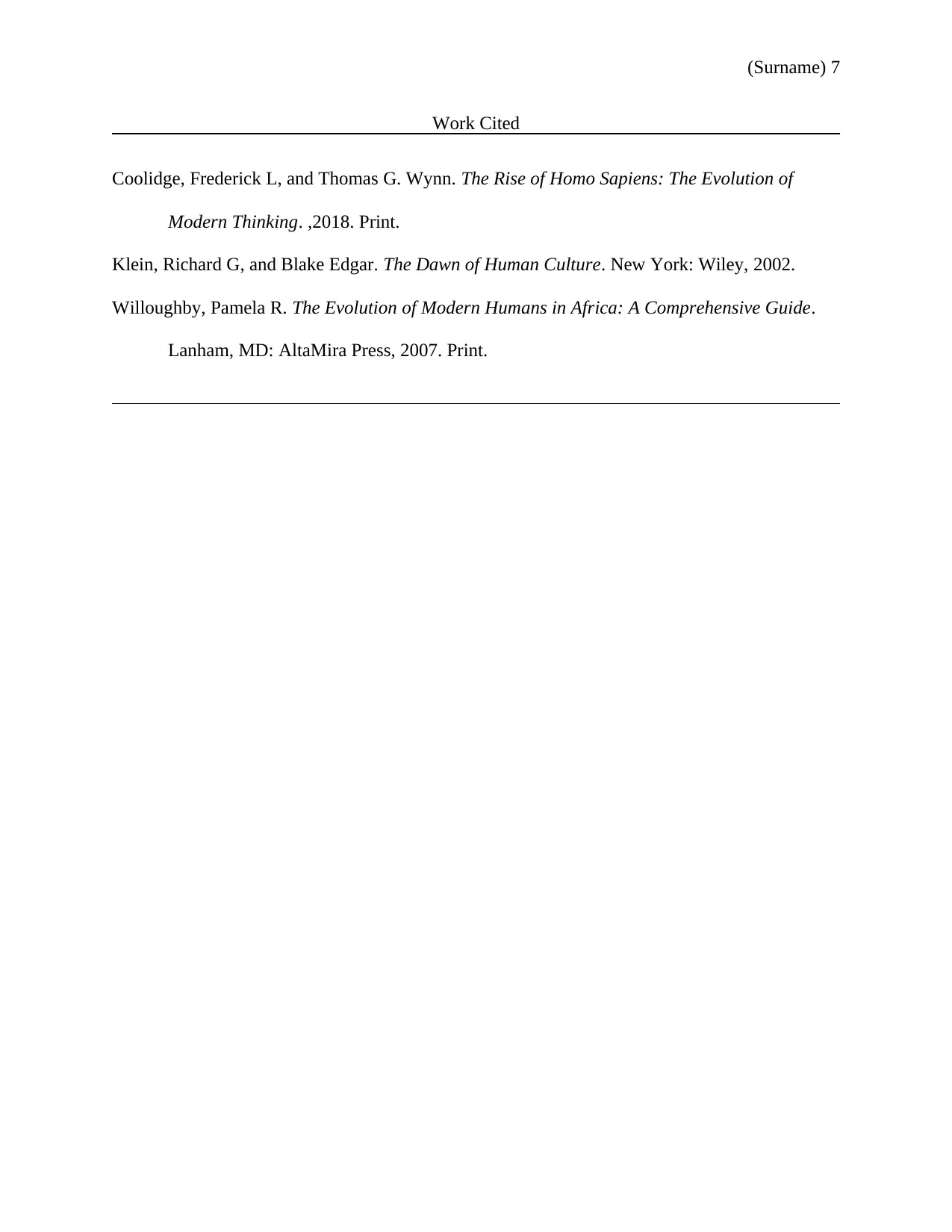
(Surname) 7
Work Cited
Coolidge, Frederick L, and Thomas G. Wynn. The Rise of Homo Sapiens: The Evolution of
Modern Thinking. ,2018. Print.
Klein, Richard G, and Blake Edgar. The Dawn of Human Culture. New York: Wiley, 2002.
Willoughby, Pamela R. The Evolution of Modern Humans in Africa: A Comprehensive Guide.
Lanham, MD: AltaMira Press, 2007. Print.
Work Cited
Coolidge, Frederick L, and Thomas G. Wynn. The Rise of Homo Sapiens: The Evolution of
Modern Thinking. ,2018. Print.
Klein, Richard G, and Blake Edgar. The Dawn of Human Culture. New York: Wiley, 2002.
Willoughby, Pamela R. The Evolution of Modern Humans in Africa: A Comprehensive Guide.
Lanham, MD: AltaMira Press, 2007. Print.
1 out of 7
Your All-in-One AI-Powered Toolkit for Academic Success.
+13062052269
info@desklib.com
Available 24*7 on WhatsApp / Email
![[object Object]](/_next/static/media/star-bottom.7253800d.svg)
Unlock your academic potential
© 2024 | Zucol Services PVT LTD | All rights reserved.